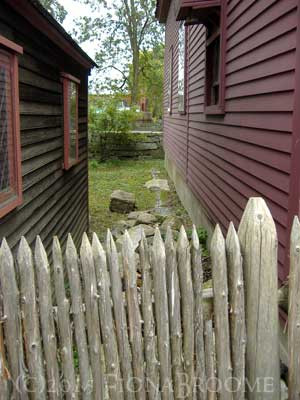 Tenney Gatehouse and Greycourt Castle – today, the Methuen Museum of History – is known for its many ghosts.
Tenney Gatehouse and Greycourt Castle – today, the Methuen Museum of History – is known for its many ghosts.
Two of them seem to haunt the property behind the main building.
They’re the feuding Gorrill brothers, and they may still be searching for a disputed buried treasure.
Here are the facts.
Nathaniel (1784 – ? ) and Lavinia Smith Gorrell of Salem, New Hampshire, had two sons. One was Mark S., born about 1816, and the other was Nathaniel W., born about 1821.
The family moved to Methuen, Massachusetts, in the mid-19th century. Nathaniel Senior’s father – the late Major Nathaniel Gorrell (1734 – 1821) – had owned land there.
The Gorrells, the Gorrills, Daddy Frye, and the Tenneys
The Gorrell family – who later spelled it Gorrill – established their homestead “on Daddy Frye’s Hill near the Castle,” according to a 1937 book.
The “Castle” refers to Greycourt Castle, the Charles H. Tenney estate.
The Gorrill family was prosperous. In the 1850 census, their property was worth $3600, considerably more than their neighbors’ land. (That’s about $90,000 in 2009 dollars, though that parcel of land would sell for considerably more than that now.)

The sons, Mark (age 34) and Nathaniel (age 29), were both single in 1850. Both lived at home with their parents.
And Then the Lies Began
The story takes an interesting turn in the 1860 census. Instead of being 44, Mark reported his age as 40. Following his brother’s lead, Nathaniel claimed to be 36 instead of 39. Both remained single and still lived at home.

In the 1860 Methuen city directory, all three men in the family were listed with an East Street address.

By 1870, the brothers had recovered their maturity – or at least reported their ages correctly – and had acquired a housekeeper, Kate Robertson from Maine. Perhaps she was the woman they fought over?

Alas, by 1880, they were on their own again and left the “relationship to head of household” line conspicuously empty.

In 1900, their names weren’t in the census index. According to the stories, they died within a couple of years of each other.
Questions Linger After Death
In 1909, the question of bonds resurfaced. The estate of Mark S. Gorrill said that his bonds were missing.

Despite several later claims regarding the missing treasure, no one has firmly established what happened to both Nathaniel and Mark Gorrill’s fortunes.
If the Gorrill brothers haunt Tenney Gatehouse – at least the hill behind the Methuen Museum of History – they could be looking for the lost treasure… and still feuding.
My Methuen investigations suggest layers of hauntings, representing many power struggles at the Tenney site. I believe the Gorrill brothers are just two of the ghosts that linger there.
YOU MAY ALSO ENJOY:
- An Investigation at Tenney Gatehouse
- Ghosts at Greycourt Castle Ruins (with photos)
- The History of Tenney Gatehouse’s Ghosts
- Tenney’s Greycourt Ghosts – the Gorrill Brothers

References
Legendary Massachusetts Lost Treasure Stories and State History (at Wayback Machine)
Massachusetts: a guide to its places and people (1937)
Police call Methuen treasure story a tall tale (2005)
United States Statutes at Large Volume 35 Part 2.djvu/278 (1909)

Trivia: Charles H. Tenney is not the only Tenney linked to a tale of hidden treasure.
According to an 1888 story, John L. Tenney (b. 1855 in California) — then living in Catron County, New Mexico — was visited by a cattle driver named John Brewer. Brewer was one of the few survivors of the “Lost Adams Diggings Curse,” and told his story to John Tenney. (That legend was the basis of the Gregory Peck movie, “Mackenna’s Gold.”) For more information on that buried treasure, see Wikipedia.
Photo credit, 19th-century photo of Greycourt: EraserGirl [CC BY 2.0 (https://creativecommons.org/licenses/by/2.0)], from Wikimedia Commons





 Today, a site called Gallows Hill rises above a children’s playground and sports field. It’s surrounded by single-family homes in a quiet residential neighborhood.
Today, a site called Gallows Hill rises above a children’s playground and sports field. It’s surrounded by single-family homes in a quiet residential neighborhood. Researchers may never document the exact location of the hangings, or where most of the so-called witches’ bodies were buried. That includes the body of Giles Corey,** remembered for one of the Salem curses.
Researchers may never document the exact location of the hangings, or where most of the so-called witches’ bodies were buried. That includes the body of Giles Corey,** remembered for one of the Salem curses.
 Every time I study profoundly haunted communities, patterns seem to emerge.
Every time I study profoundly haunted communities, patterns seem to emerge.


